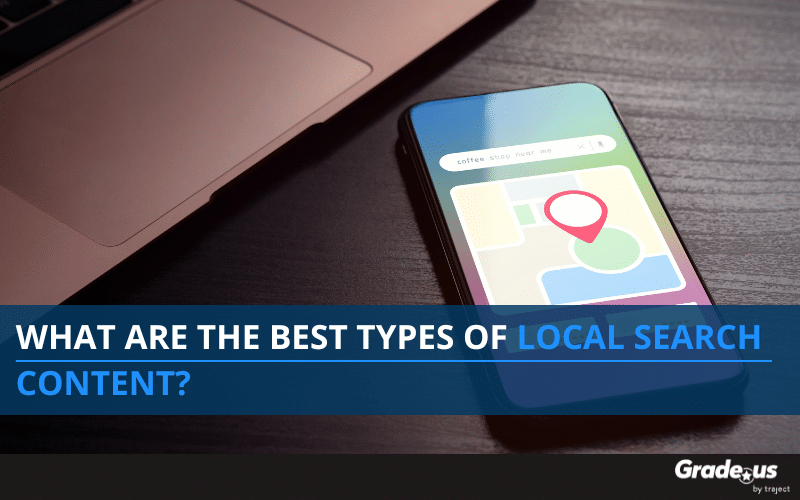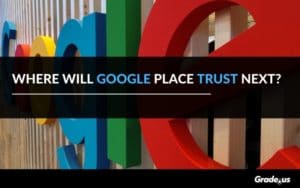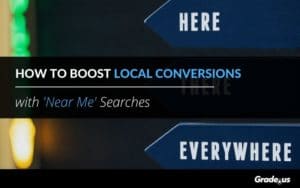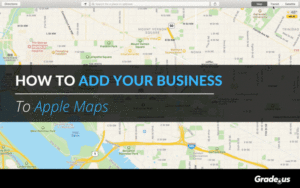What are the best types of content for your clients?
More specifically, which types of local search content lead to better rankings, more traffic, and increased revenue for your client’s business? This may seem like an obvious question as an agency, but it’s not.
Believe it or not, some content is actually bad for business.
Why local search content types matter
Google acts as a gatekeeper.
Their 84.08% market share means they control most websites’ visibility, traffic, and to a lesser degree, their revenue.
If you want more revenue, you’ll need to appease Google.
How do you do that?
You shift your focus from Google to your users. You focus on the user experience and making them happy. In fact, this is what the helpful content update is all about.
How do you do that?
- Apply lessons from E-A-T and the helpful content update
Google wants us to focus on E-A-T content. With Google looks at:
- The expertise of the creator behind the main content
- The authoritativeness of the creator, the content itself, and the website as a whole
- The trustworthiness of the creator, the content itself, and the website as a whole
Google wants to see that your clients are creating high-quality pages that have a beneficial purpose. These web pages have a high level of E-A-T in sufficient volume to convey expertise and authoritativeness. High-quality sites have a positive reputation, as do their content creators.
What about the helpful content update? Here’s what Google has to say about this update:
“The update rewards content that provides a satisfying experience for visitors.
Content creators should focus on creating content for people, not for search engines, and should follow SEO best practices.
Content should be created with an existing or intended audience in mind and should leave readers feeling like they have learned enough to help them achieve their goal.” – emphasis added.
What are the implications for your content? To succeed with local search, you’ll need to:
- Build expertise: Share original research, case studies, and verifiable factoids, create content for industry-recognized sources, share helpful tools, and continue to be a reliable thought leader.
- Build authoritativeness: Governing bodies, reputable, third-party sources, awards, recognition, industry recognition, blogger reviews, and original research are all great ways to build authoritativeness.
- Borrow trust: Borrow trust from trustworthy sources. Partner with reliable sources, guest post for well-known publications, and partner with established players to create original research.
This is what Google wants.
- Use ranking factors as a guide
Darren Shaw from Whitespark broke down local search ranking factors. The following list is an indication of the most important ranking factors present in Google.
- Google My Business (GMB): Your GMB page gives Google important details about your business, including details on categories, keywords, proximity, and contact information.
- Citations: Any mention of your company online is a citation. Citations come in two flavors – structured citations (e.g., your company’s name, address, and phone number ‘NAP’) and unstructured citations (e.g., a casual mention of your business on forums, in blog posts, etc.).
- On-page: Factors on your web page that convey relevance, proximity, and prominence. These factors include NAP, keyword usage, page titles, domain rank, etc.
- Online reviews: First and third-party reviews are objective indicators of quality. Google looks at metrics like review ratings, review velocity, and review diversity, using these metrics to gauge trustworthiness.
- Links: Inbound links are still an important part of the ranking process. Factors like domain authority, linking domain quantity, and anchor text helps link equity flow through a site and the web. Google uses inks to measure the importance of a web page.
- Behavioral: Dwell time, time-on-page, click-throughs, and click-to-call are all indicators Google can use to assess performance. The better your performance, the more visibility you’ll receive.
What does this tell us?
- Your GMB page is a must-have. It needs to be nurtured, optimized, and consistent with your content across the web to be effective.
- You’ll need a mix of content: The specific blend depends on your industry but generally includes on-page content, third-party mentions and content, directory and listing pages, review profiles, social media profiles, and links.
- Your content (specifically citations) needs to be consistent across the web. Use the right contact details for your landing pages, review profiles, GMB, and social media profiles.
- Review management is an ongoing, neverending process. Customers treat reviews older than three months as stale.
- Copywriting and content development are foundational skills. If Google looks at behavioral markers, you’ll need to create content that gets your client’s customers to act. The better you are at generating conversions, the easier it will be to increase visibility.
- Links are also an ongoing, never-ending process. You’ll want to develop a diverse link portfolio that includes inbound and outbound links as well as internal and external links from high-quality, high-trust sources.
Why do agencies struggle to produce high-quality content?
The content you produce directly correlates to the revenue you earn. As an agency, you’re expected to create value and growth for your clients.
It’s a tough position to be in.
Experienced agencies realize several client-induced barriers preventing them from generating the results their clients want.
- Clients who know best: These are the clients who are unwilling to trust. They know what pulls; they give you step-by-step instructions, micromanaging their campaign.
- Uncommitted clients: These clients are minimally involved. They can’t be bothered to remain an active presence in their campaign. As a result, their outcomes are less than expected (which you’ll still be blamed for).
- Shortcut seekers: These clients are desperate. Their circumstances require that they get results now. They’re looking for immediate results, quick wins, and short-term outcomes, and they’re willing to do anything to get them.
- Low spenders: Clients like these mean well, but they can’t afford to invest sufficiently in their campaigns. They’re looking to spend the minimum because that’s all they can afford. Their competitors are outspending them 2 to 1, but they’re still expecting to keep up.
These are tough challenges to overcome.
But you have to do it.
You’ll need to have a frank discussion with your clients about these issues; if they’re willing to work with you, great. If they’re unwilling to work with you, it will be challenging to produce the kinds of results they need to grow.
How to 2x the value of your local search content
Is it possible to double the value of your content?
It is if your content is structured around a content development plan. There are many ways to 2x your content; frankly, that’s where most of the attention should be placed (assuming that you’re good at creating content). Here are several tactics you can use to 2x the value of your content.
- Use PPC + analytics to identify your conversion keywords. These are the keywords that produce excellent returns with below-average investment.
- Start with your Bottom of Funnel (BoFu) content: Create content that leads to a sale. Add ToFu and MoFu content as your testing dictates. Spend a significant amount of time researching content that will perform well. Create your content, then give your content time to produce results.
- Optimize organic and local content: Work to optimize on-page and off-page content/web pages. Use the keywords you’ve identified in step one to generate consistent income as you scale your campaign up. Continue doing all of the things you’d normally do in an SEO campaign.
- Create a list of tangential partners: These high-quality sources produce E-A-T content. These partners serve the same audience you do in a different but complementary way. Divide these partners into two groups – original and syndication partners.
- Create high-quality E-A-T content for your partners: Give original partners original content. Give syndication partners strong content you’ve created on your site that they can syndicate. Original partners are typically looking for high-quality content that drills deep. Syndication partners generally are looking for high-quality, high-volume content.
- Combine content with offers: Create irresistible offers with a strong value proposition that appeals to your clients and their customers. Use urgency triggers, risk reversals, and vanishing bonuses to motivate customers to take action quickly. Create a promotional calendar to track the offers, incentives, and terms of each promotion.
- Share rewards with your partners: Whenever possible, share these offers with your partners. Work to include your partners wherever it makes sense to do so. Just be sure to maintain control over the content, product, and money-changing hands. Use third-party tools like Tune to provide your partners with transparent reporting.
Can you see what’s happening?
These strategies, when used in tandem, produce a virtuous cycle. Your partners are eager to promote your content; this increases your perceived expertise, authoritativeness, and trustworthiness in Google. As your domain authority improves, it becomes easier to rank for your target keywords.
Both strategies produce revenue as your campaign ramps up.
It’s an absolute win for your agency, your clients, and their customers. It’s a repeatable process you can use to generate consistent growth on demand, even in a down economy.
What’s the best kind of local search content?
More specifically, which types of local search content lead to better rankings, greater visibility, more traffic, and increased revenue for your client’s business?
Google shared the answer.
It’s high-quality E-A-T content that’s focused on the user.
Google wants to see that your clients are creating high-quality pages that have a beneficial purpose. These web pages have a high level of E-A-T in sufficient volume, conveying the expertise and authoritativeness Google is looking for. High-quality sites have a positive reputation, as do their content creators.
The strategy I’ve shared is a two-pronged attack.
Create high-quality E-A-T content for your users consistently, and you’ll find Google is eager to reward you with the rankings, visibility, and traffic you deserve.











